Allegro
Gene Perla’s Brighter Day
Feature profile
Volume 120, No. 5May, 2020
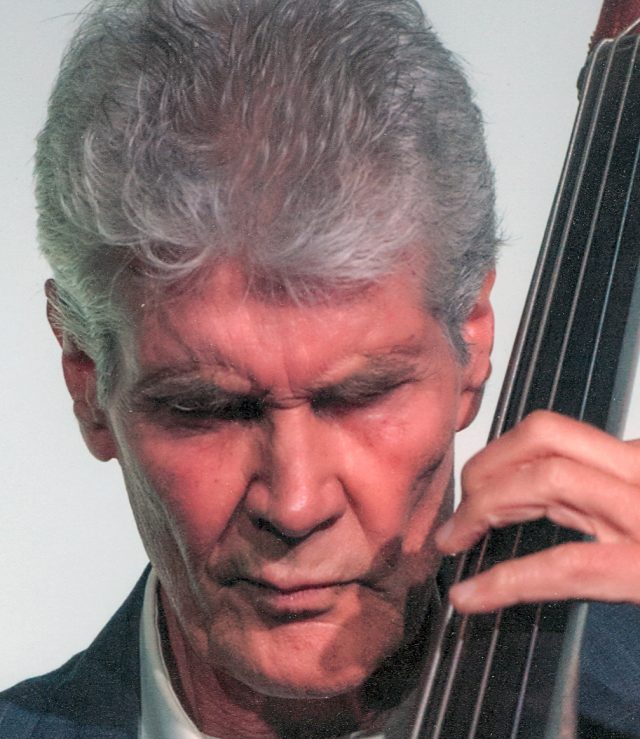
Gene Perla (photo by Richard Stopa)

By Todd Bryant Weeks
Gene Perla walks into his study, tall, lanky and youthful and sits down at his computer and waves to me… at the other end of our virtual space.
He looks up, sees I’m there and hits me with his signature warm smile and affable greeting:
“Hey, baby!”
At 80, one might think Perla would be slowing down after an incredibly rich career as one of the most in demand bassists in jazz. Yet he continues to tour, teach, attend conferences, compose and work actively on union committees, including the New School Negotiating Committee and the New School Stewards. He’s had his own CBA with Local 802 for over a decade.
Gene rarely talks about himself, and in this case, I have to convince him to drop committee business for a while so that we can talk about his life.
“Covid-19 has really pulled the rug out from under me in terms of being able to perform and make money,” he says. “In that regard, I guess I’ve got some time to talk!”
Some of Gene’s story is well known: how he started playing with the Woody Herman Orchestra in 1969 when he was right out of college and soon found himself backing Nina Simone and Sarah Vaughan. Between 1971 and 1973, Perla also enjoyed a solid association with legendary drummer Elvin Jones, with whom he recorded a number of highly regarded albums. He’s also had associations with Miles Davis (he’s on the “Jack Johnson” LP), Sonny Rollins, Stan Getz, Stone Alliance and Frank Sinatra, and these days he leads many of his own units including his latest band called Star Wonder, featuring saxophonists Roxy Coss and Nicole Glover. His career, as a sideman, leader, sound engineer and record producer has taken him all over the world over six decades. I ask him about his beginnings.
“I can’t imagine people really want to know about my childhood but there are a few stories there,” he says.
“Both sides of the family are Italian,” he begins. “My father, Joseph Perla, was a construction Mason who was born in a place called Bogno di Besozzo, in Italy, in 1901. That’s in Lombardy, by the way — where they’ve had so much Covid-19. My mother, Mary Louise, her family name was Mazzola, was a fashion designer who was born in Brooklyn. My grandfathers were a railroad conductor and an engineer respectively. Actually, my mom’s dad was a nonprofessional musician who played several instruments.”
Gene tells me that he grew up in northern New Jersey. “My mom had a home business and she loved music,” he says. “She had the radio on when she worked and was a ‘station flipper.’ She started me on piano lessons at the age of five. She bought me some 78s of cowboy music, Gene Autry, which I liked. My father was also crazy about watching cowboy movies on TV. My first piano teacher was a Mrs. Mendelsohn, a very sweet woman who, when I advanced, suggested I get a stronger teacher. Ancha Seidlova was a classical concert piano performer who was impatient with my lack of interest in the music.”
Gene’s phone rings and he pauses for a moment. It’s a call from one of the other stewards at the New School. They discuss the difficulties of virtual classroom situations, specifically as it relates to ensembles…and how teaching an ensemble with seven or eight students in different locations seems almost impossible.
“Thank goodness for the 802 contract with the New School,” he remarks when he returns. “For me the center of trade unionism is always about collective action. In most cases, groups of people can accomplish more than individuals. Beyond that, especially with Covid-19 bursting upon humanity, having support in the form of employer-contributed health insurance can be a blessing.”
He adds, “We have great health insurance via the 802 contract with the New School and it’s to the credit of the all musicians who demanded it and to the New School administration that they continue to contribute, especially in these uncertain times.”
We circle back to his early days. In grammar school, Perla played a bit of baseball. In high school, he tried out for the basketball team in his senior year and made junior varsity, but he quit before the first practice. In high school he became enthralled with cars. He remembers, “My best friend and I bought old junkers and raced them around an oval track.”
In his first year of high school, Perla wanted to join the band as a trumpeter but was given a “take it or leave it” trombone command from the director.
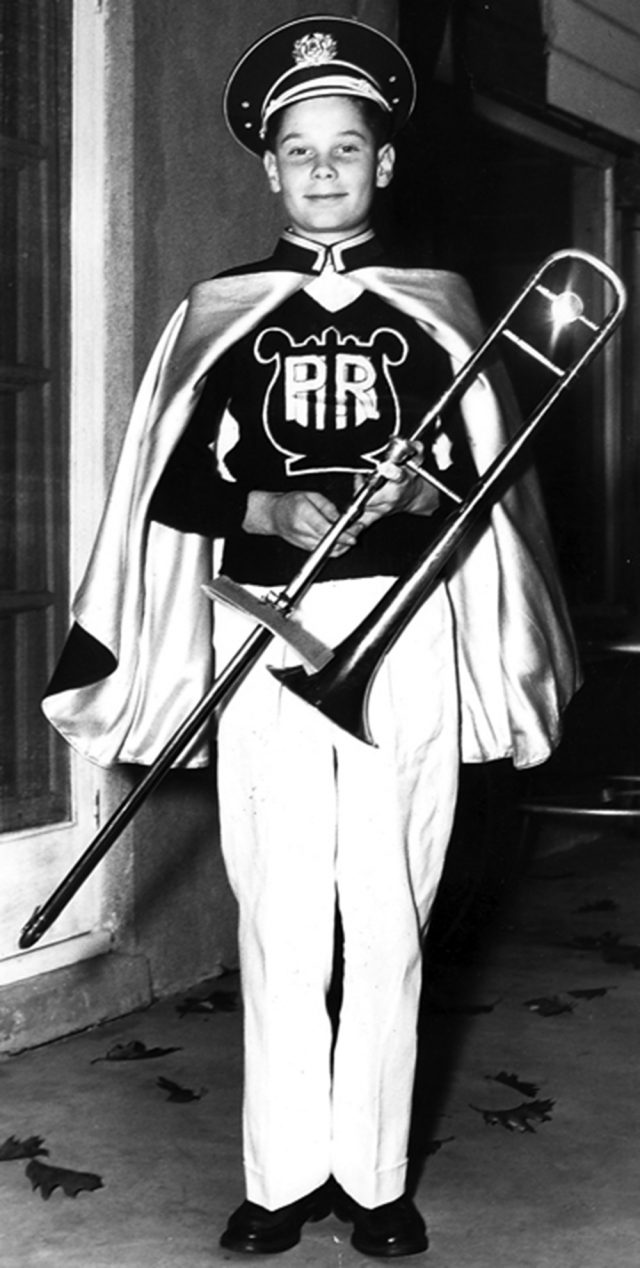
Gene Perla in his high school marching band uniform
He took a few piano lessons from a jazz piano teacher who showed him Nat King Cole’s “Easy Listening Blues,” which he learned note for note.
In his third year of high school, Gene met Sandy O’Meara, an alto saxophonist who introduced him to the music of Ted Heath’s big band. He was hooked.
“I bought at least a dozen of his albums,” Perla remembers, “and later attended his concert in New York City. Without my knowing it, my mom had contacted him and when the show was over, I met him and a few members of the band.”
Because Perla’s high school grades were weak, he ended up at New York Military Academy on a trombone scholarship to raise his chances of attending college.
Perla was accepted to Toledo University, and, in his fourth year there, he heard Bill Evans’ “Sunday at the Village Vanguard.” It made a huge impact on him. He headed to the Berklee School of Music to major in piano. At age 24, he heard Ornette Coleman’s “The Shape of Jazz to Come” and immediately switched to double bass. Later when he met the band’s bassist Charlie Hayden, he told Hayden that he was the cause of Perla’s switching instruments. “Charlie got a kick out of that,” remembers Perla.
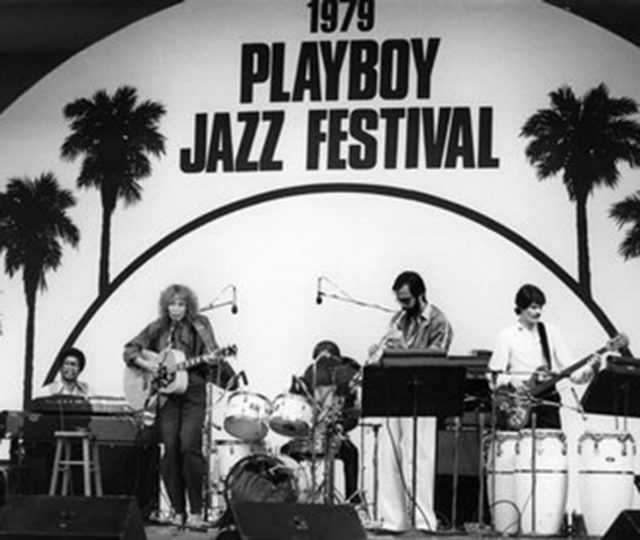
Gene Perla with Joni Mitchell, Herbie Hancock, Michael Brecker and Don Alias
While working for a popular Boston Latin band called Los Muchachos, led by saxophonist Dick Meza, Gene met his best friend for over 40 years, percussionist Don Alias, and the pianist/trombonist Mark Levine. By the mid-1960s he had moved to New York City and started gigging regularly; he joined Local 802 in 1967. Trumpeter Bill Chase called him to join the Woody Herman Orchestra, whose pianist was John Hicks. He played electric bass and traveled with Herman for two months. (“Woody introduced me to vodka martinis,” he quips.) The associations with Nina Simone and Sarah Vaughan followed, but the biggest break was yet to come. His sensibilities still leaned in the direction of the music of Miles Davis and John Coltrane and he remembers truly being in the right place at the right time one night in Boston:
“I was gigging in Beantown and hanging out in the lobby of Berklee, when WGBH called looking for a bassist to cover an Elvin Jones Trio show, with Joe Farrell, because Jimmy Garrison missed the plane coming from NYC. I raced to the station, fumbled my way through the music, playing electric and later found out that Elvin described me as, ‘a white guy who made the electric bass sound like an upright.’ Soon after that, back in New York, I got the gig with him which led to a lot of other connections, including me joining the Thad Jones-Mel Lewis Orchestra, taking Richard Davis’ place in the bass chair.”
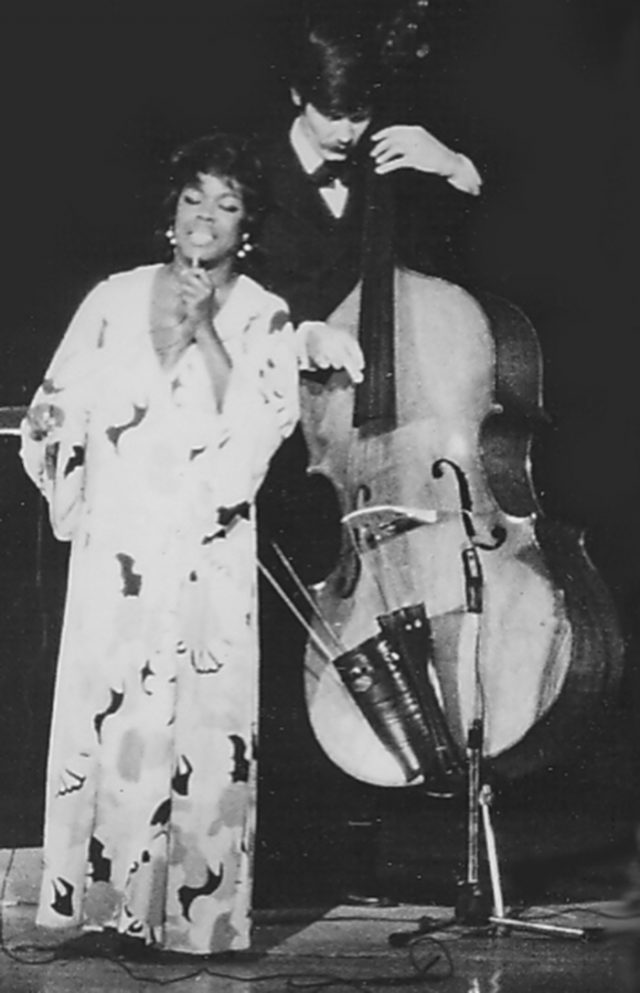
Gene Perla and Sarah Vaughan
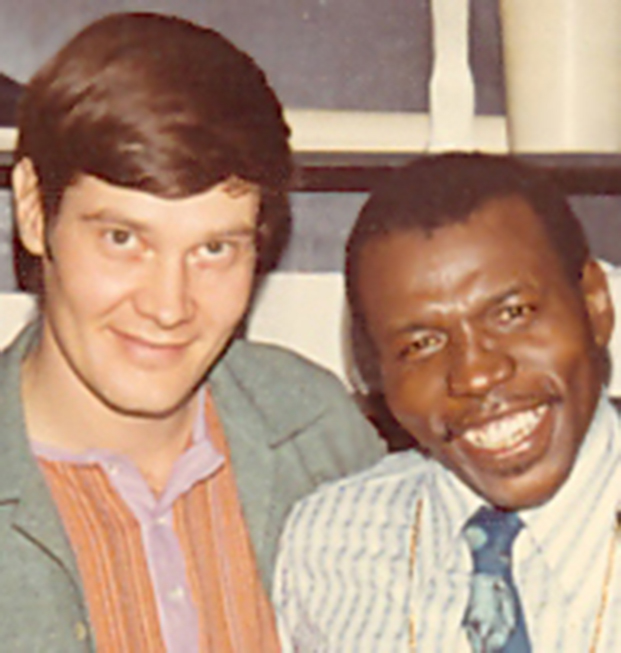
Gene Perla and Elvin Jones
Over the years, Gene has had some memorable experiences that took him outside of the jazz world. While teaching in New York City at the Center for the Media Arts, he got connected with Bernard Fox, a master of multiple media, technology and more. Together, they formed Fox and Perla, doing audio visual capturing and editing, sound design for Off Broadway and Off-Off Broadway shows and buying and selling A.V. equipment. One day in 1979, Perla ran into Richard Fitzgerald, the president of Sound Associates, who asked him if he knew anything about MIDI to which Perla said, “Yes!”
“At that point, I knew MIDI down to the bit level. Richard took us to Circle in the Square where they were doing the Sondheim show ‘Sweeney Todd.’ The orchestra was three keyboard players and a conductor. They were having difficulty with some of the sound patches, so my partner Bernard and I suggested we rewire everything. Fitzgerald freaked out, saying, ‘The show opens tonight!’ But we did the job and we were 100 percent successful.”
That led to Perla designing sound for myriad shows, including ‘City of Angels,’ ‘Beauty and the Beast’ and ‘The Lion King,’ which garnered Tony awards.
Sound engineering came about when Perla decided to start a record label, which is a whole other story. He attended the Institute of Audio Research on University Place in NYC. After the first class, he headed for a drink at Bradley’s where he had played many gigs. There, Perla met Mark “Moogy” Klingman, who was Todd Rundgren’s MIDI guy. Klingman offered Perla a gig at their studio. He assisted Klingman on several recordings and met Bob Dylan, Bette Midler and others. During a recording session with Hall and Oats, Klingman suggested to them that a particular track could use a double bass.
“Up to that point, Rundgren had no idea who I was in terms of being a player, so I piped up, ‘I play it,’ remembers Perla. “He told me to bring it the next day and when he heard me warming up, he started jumping up and down and said, ‘You really can play that thing.’ From then on, we became good friends. I wasn’t just an assistant anymore. It’s amazing how music can affect people and situations.”
For the past several years, Gene has been putting together bands of many different styles: Go Trio is a classic piano trio; Vik and Gene Perla features a wide range of music with vocals; Funk Express is a jazz funk band; New Light celebrates the music of Elvin Jones; Galvanic Ignition is a two guitar quartet, and then there’s his newest endeavor, Star Wonder.
“When Covid-19 finally departs,” he tells me, “I will go back to the house band at the Porter Pub in Easton, Pennsylvania, with drummer Bill Goodwin and guitarist Bill Washer.” Other local clubs he plays are the Lafayette Bar and Two River Brewing Company.
After more than 50 years as a professional musician, I asked Gene if he recalls some memorable moments that stand out.
“There are so many. Some of them are not fit to print,” he laughs. “But I do remember some amazing experiences like being in Della Reese’s kitchen having a jam session with Sarah Vaughan, Carmen McRae and Gene Ammons. I remember playing a ballad with Nina Simone at the Concertgebouw in Amsterdam, where you could hear a pin drop. They were so many nights with Elvin Jones that were stupendous, but I remember one night in particular, after a particularly energetic set at Slugs, a famous club on the Lower East Side, when I was approached after the set by the great Czech bassist, George Mraz who said to me, simply, ‘You must be crazy.’ It was a high compliment.”
“Oh, yes,” he adds and his cherubic grin appears, “And Sinatra. I remember playing a New Year’s Eve gig at his home in Palm Springs with Pat Rizzo’s quintet where he sang with us; I have a recording of it. I left L.A. for the gig, but I was too late and I knew I wouldn’t be on time. Being late for Sinatra did not sound like a bright idea. The band was already playing when I arrived and as I started towards the party room, with a both a borrowed double bass under one arm and my electric bass on the other, a figure appeared out of the darkness, came up to me and said “Give me the Fender. Follow me.” It was Frank.
I ask Gene again about current projects.
“Listen,” (he can be very direct at times), “with this crazy Covid-19 thing happening, we all are reeling. It’s inconceivable what’s happened. But that’s why it’s important to look ahead and to have some vision for the future. My group Star Wonder gives me hope. That will offer opportunities primarily due to the limitless talents of Roxy Coss and Nicole Glover. We played a few gigs together and it was a joy to see the way the two of them interacted. Both musically and socially. They are good friends and have deep respect for one another. From my perspective, they are killin’. The main thing is, we all have to stay positive together, look ahead and realize that we will all get through this. There will be a brighter day. That’s it, baby!”
